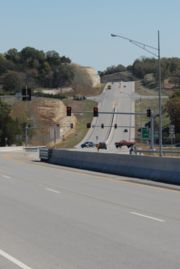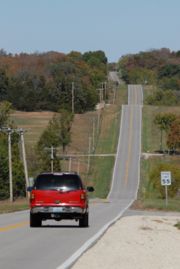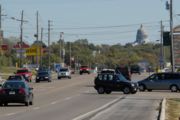Difference between revisions of "Category:233 At - Grade Intersections"
m (updated link) |
m (updated link) |
||
| Line 40: | Line 40: | ||
Other factors can also affect the efficient operation of an intersection. These are: | Other factors can also affect the efficient operation of an intersection. These are: | ||
[[Image:233 Photo 3.jpg|180px|right]] | [[Image:233 Photo 3.jpg|180px|right]] | ||
| − | * The presence of [[641 | + | * The presence of [[:category:641 Bicycle Facilities|bicyclists]] |
* The presence of [[:Category:642 Pedestrian Facilities|pedestrians]] | * The presence of [[:Category:642 Pedestrian Facilities|pedestrians]] | ||
* The presence of [[:category:901 Lighting|lighting]] | * The presence of [[:category:901 Lighting|lighting]] | ||
Signalized intersections can be considered for expressways that pass through communities. In a rural area, a designer is not to consider including a signalized intersection for a new expressway, although one may be installed at an existing expressway intersection with the recommendation of the Traffic Division. The distance between intersections along MoDOT roadways is dependent on whether the road is major or minor, rural or urban. The [[:category:940 Access Management|Access Management Guidelines]] is to be used to determine desirable spacing of at-grade intersections. The NCHRP 500 series is a good source of information when considering improvements at an at-grade intersection. | Signalized intersections can be considered for expressways that pass through communities. In a rural area, a designer is not to consider including a signalized intersection for a new expressway, although one may be installed at an existing expressway intersection with the recommendation of the Traffic Division. The distance between intersections along MoDOT roadways is dependent on whether the road is major or minor, rural or urban. The [[:category:940 Access Management|Access Management Guidelines]] is to be used to determine desirable spacing of at-grade intersections. The NCHRP 500 series is a good source of information when considering improvements at an at-grade intersection. | ||
Revision as of 08:17, 5 November 2010
An at-grade intersection is an area where two or more roadways join or cross. It also includes the roadside facilities for traffic movement within the area. Each intersection involves through or cross-traffic movements on one or more roadways and may involve turning movements between these roadways. The main objective of the intersection is to facilitate the convenience, ease, and comfort of people traversing the intersection while enhancing the safe and efficient movement of motor vehicles, bicycles and pedestrians. To accomplish this task, the intersection must have the capacity to handle all the volume of traffic flowing through it.
| Rural Expressway, Median Crossovers |
| Report 2001 |
| Report 2004 |
| Summary 2004 |
| See also: Innovation Library |
There are five basic elements to be considered in the design and operation of an intersection
- Human factors
- Traffic and safety considerations
- Physical elements
- Economic factors
- Functional intersection area
Intersections having three or four legs are the most common and efficient in their operation. Intersections with more than five legs are to be avoided. Basic traffic management at an intersection can be placed in one of the following categories:
It is important to provide adequate sight distance clear of obstructions within the functional area of the intersection to ensure a driver’s view of other vehicles is not blocked.
While most individuals understand intersections occur at roadway crossings, there are other types of intersections:
Other factors can also affect the efficient operation of an intersection. These are:
- The presence of bicyclists
- The presence of pedestrians
- The presence of lighting
Signalized intersections can be considered for expressways that pass through communities. In a rural area, a designer is not to consider including a signalized intersection for a new expressway, although one may be installed at an existing expressway intersection with the recommendation of the Traffic Division. The distance between intersections along MoDOT roadways is dependent on whether the road is major or minor, rural or urban. The Access Management Guidelines is to be used to determine desirable spacing of at-grade intersections. The NCHRP 500 series is a good source of information when considering improvements at an at-grade intersection.
Articles in "233 At - Grade Intersections"
The following 4 pages are in this category, out of 4 total.


